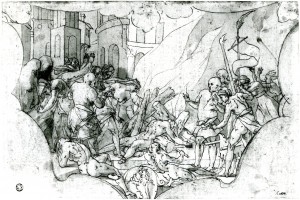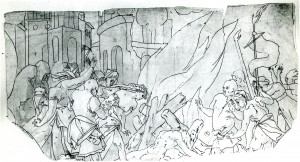For an Unexecuted Fresco in the Gallery of Francis I, Fontainebleau
1535 or 1536
D.58A. Weimar, Nationale Forschungs-und Gedenkstätten der klassischen deutschen Literatur in Weimar (Goethe-Nationalmuseum), Schuchardt I, 244, no. 117.
Pen and black and brown inks and wash, 28.1 x 41.8; laid down; wm?. Inscribed in ink at the lower right: Rosso. On the verso inscribed in ink and in a single hand: Maitre Roux / Dessein superbe. provenant. / du Cabinet Walraven vendue à Amsterdam 1765- / [du Cabinet] L.J. du Bourg a Amsterdam 1766.- / [du Cabinet] Winkler a Leipzig 1815 – / [du Cabinet] Kayl à Leipzig 1822 – / -Josh Grunling [signature], and to the left of the signature: L6.56 . [underlined] / L.9[?] – [???]. Eigene kosten.; also in pencil at the left: 444.1
PROVENANCE: Walraven; L. J. du Bourg; Winkler; Kayl (on which see inscription on verso); J. Grünling (Lugt 1107); J. W. von Goethe.
LITERATURE:
Christian Schuchardt, Katalog: Goethes Kunstsammlung, I, Jena, 1848, 244, no. 117, as Primaticcio.
Zerner, 1967, under A.F. 21, as Rosso’s composition.
Carroll, 1987, 242, 244, n. 1 under no. 75, as a copy of a lost drawing by Rosso of 1535 or 1536.
D.58B. Montpellier, Musée Fabre, inv. no. 864-2-626 (formerly 3180?).
Pen and ink and wash, 19 x 36.7, irregularly cut on all sides, the lower corners missing as well as the bottom third of the composition; creased down the middle; wm., part of a curving pointed shape (ray?) at the lower left.2
LITERATURE:
Carroll, 1987, 242, 244, n. 1, as a copy of a lost drawing by Rosso of 1535 or 1536.
As discussed in P.22, III S, and in Chapter VIII, these drawings are copies of a lost drawing by Rosso that was used by Fantuzzi to make his etching (Fig.E.72). But the drawings show the architecture somewhat less complete – see the absence of moldings on the circular building in the center of the background – and two men are bald in the drawing that have hair in the print. The absence of these details is found elsewhere in Rosso’s drawings, as in the Allegory of the Virgin as the Ark of the Covenant (Fig.D.33Aa) and the Design for a Chapel (Fig.D.37a). They would have been supplied in the final works, as they have been added by Fantuzzi to his etching.
Before discussing these drawings further, it should be pointed out that both of them differ from Fantuzzi’s print in several other more significant details. The drawings show clouds entirely encircling the scene, which, in the complete Weimar drawing, eliminates an entire figure from the lower left corner. A large building with pilasters is also missing at the right – it appears at the left in the print – and at the bottom center of the scene in the Weimar drawing there is a shield with a rampant lion holding what seems to be a mace. The reclining nude boy to the right of it leans with his left arm and hand on the shield, while in the print his hand touches the ground. It seems, then, that the drawings show a re-working of Rosso’s design, probably not by Rosso, to adapt it to some other use when it was not painted in the area now occupied by the Death of Adonis in the gallery.3 It is also possible that the Montpellier drawing was copied from the slightly more detailed Weimar sheet. The second torch in the Weimar drawing is drawn only with wash, and this is vaguely repeated in the other drawing. The composition is more faithfully recorded in Fantuzzi’s etching, which would seem to be directly dependent on Rosso’s lost drawing.
Nevertheless, even though the composition has been slightly re-worked, but mainly by eliminating a few elements, not by any elaboration of the scene, the drawings reflect Rosso’s style. The figures are clearly his. At the left, the bent over woman with hands clasped before her resembles the old woman with a hammer at the right of the relief beneath the Centaurs and Lapiths fresco in the gallery (Fig.P.22, I S c). In the center, the young woman with streaming hair is similar in pose to the figure at the far left of the Twins of Catania (Fig.P.22, V N a). The pose of the nude corpse with its arched chest suggests that of the body of Christ in the Borgo Sansepolcro Pietà (Fig.P.19a). The background architecture functions as a setting like that in the Unity of the State (Fig.P.22, VI S a). In the drawings, there appears to be a glimpse into the distance to the left of the round building, as in the Unity of the State; in the print there are buildings here, perhaps added by Fantuzzi. Compositionally, the Funeral of Hector, with its central episode flanked by standing groups at left and right, is somewhat related to the Unity of the State, although the former, because of its subject, is more dramatically active, suggesting a later date. Thus, on stylistic grounds, there is every reason to believe that the drawings preserve a composition by Rosso.
Poor as the penmanship of the drawings is, it nevertheless reflects the kind that appears in Rosso’s Design for an Altar (Fig.D.38a), in his Annunciation in the Albertina (Fig.D.43a), and in the Petrarch drawing at Christ Church (Fig.D.47a). Similar quite regular contours appear in all these drawings, with some interior details described with small and frequently parallel strokes. The background architecture is almost haphazardly delineated but in its simple outlines it is drawn quite like the buildings in the background of the Petrarch drawing. What is not so easy to evaluate is the handling of the washes. There are basically two values of wash and they are applied more or less consistently with respect to a source of light from the upper left. They bear some resemblance to the washes in Rosso’s Pandora drawing (Fig.D.67a). Thus, given also the kind of penmanship that appears in the copies, it is possible that the original drawing was also executed in pen and ink and wash. But it is also possible that it had white highlights and a dark ground like the Petrarch drawing and the lost original of Rosso’s study for the first version of the Scene of Sacrifice (Fig.D.50B).
As argued in P.22 and in Chapter VIII, the Funeral of Hector, with Hector’s son Francus holding the baton in the foreground,1 would have been designed for the area occupied by the Death of Adonis, which was conceived after 10 August 1536. However, on stylistic grounds, the Funeral of Hector does not seem to be among the earliest compositions that Rosso designed for the gallery. It has more of the energy and dramatic force of such scenes as the Cleobis and Biton (Fig.P.22, V S a) and the Enlightenment of Francis I (Fig.P.22, VII S a), which are datable, as inventions, probably in 1535 or 1536. Hence, the lost original drawing of the Funeral of Hector would appear to have been done in these years.
PRINT: Fantuzzi, E.72 (Fig.E.72). Etching derived from Rosso’s original drawing or from a copy of it, but not from D.58A or B.
1 I should like to thank Dr. Dieter Eckhardt for information on this drawing and for photographs of it. The drawing was kindly brought to my attention by Sylvie Béguin.
2 I should like to thank M. Jean Claparède for information on this drawing and for a photograph of it.
3 It could be thought that the copies represent Rosso’s lost drawing faithfully and that it is Fantuzzi’s etching that misrepresents it by eliminating the clouds, supplying the parts of the figures that they conceal in the drawings, adding the seated male nude in the corner, as well as eliminating the shield and changing the position of the nude boy near it. But the awkward posture of this boy in the drawings, and the blimp-like clouds arranged symmetrically, can hardly be attributed to Rosso. Furthermore, the rampant lion on the shield seems not to have any meaning in relation to Francis I. However, the addition of the shield with its emblem indicates that whoever modified the scene knew that the issue of rule was an aspect of its original meaning.
4 On the subject of Francis, or Francion, see, besides Chastel, 1972, 143, Margaret R. Scherer, The Legends of Troy in Art and Literature, New York and London, 1964, 224-227, and Pierre Jodogne, “Les ‘Rhétorigueurs’ et l’Humanisme,” in Humanism in France, ed. A. H. T. Levi, New York and Manchester, 1970, 161, 172-173, n. 66.


